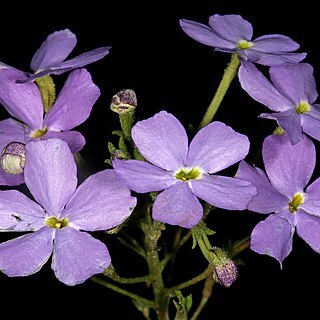Subshrub up to c. 0.5-1.2 m tall, stem simple to sparingly branched, eventually well-branched above into a paniculate inflorescence, glandular-hispid, hairs up to 0.5-1 mm long, glistening glands as well, closely leafy. Leaves alternate, pseudofasciculate, primary leaves up to 15-55 x 5-16 mm (secondary leaves smaller), elliptic, obtuse to subacute, base tapering into a petiolar part, margins serrate to crenate-serrate, both surfaces glandular-hispid, hairs up to 0.2-0.6 mm long, densely clad in glistening glands particularly on lower surface, veins impressed above, raised below. Flowers solitary in upper leaf-axils, the leaves greatly reduced in size and soon degenerating into bracts, forming a long terminal raceme, often panicled. Pedicels up to 7-25 mm long. Calyx tube 0.1-0.2 mm long, lobes c. 5.5-8.5 x 1-1.4 mm, oblong to oblong-spathulate, acute, glandular hispid, hairs up to c. 0.2 mm long, glistening glands as well. Corolla tube 20-23 x 3-4 mm in throat, cylindric, abruptly expanded near apex, mouth laterally compressed, limb slightly bilabiate, 17-30 mm across lateral lobes, posticous lobes 6-12 x 5-12 mm, anticous lobe 6-10 x 5-10 mm, cuneate to broadly ovate, apex ± rounded to retuse, glandular-pubescent outside, hairs up to 0.3-0.6 mm long, glistening glands as well, inside clavate hairs at extreme base of anticous lip and descending into the throat, upper surface of lobes minutely glandular-puberulous, scattered glistening glands as well particularly around mouth, lobes lavender-blue or mauve, white, yellowish or greenish around mouth and in throat. Stamens: posticous filaments 1.8-2.5 mm long, anthers 1.2-1.5 mm long, anticous filaments 0.8-1 mm, anthers 0.75-1.1 mm, all filaments bearded with clavate hairs. Stigma 0.5-1 mm long. Style 14-18 mm. Ovary 2.5-3.5 x 1.2-1.75 mm. Capsules 8-11 x 4-5 mm, glandular-puberulous, glistening glands as well, both outside and on the placentae. Seeds c. 1 x 0.6 mm. Flowering has been recorded in all months, but the principal period is probably March to July.
More
Subshrub, up to 0.5-1.2 m high. Leaves elliptic, primary leaves up to 15-55 x 5-16 mm, margins serrate to crenate-serrate, both surfaces glandular-hispid. Corolla tube 20-30 mm long, 3-4 mm in throat. Flowers with corolla lobes lavender-blue or mauve, white, yellowish or greenish around mouth and in throat.

